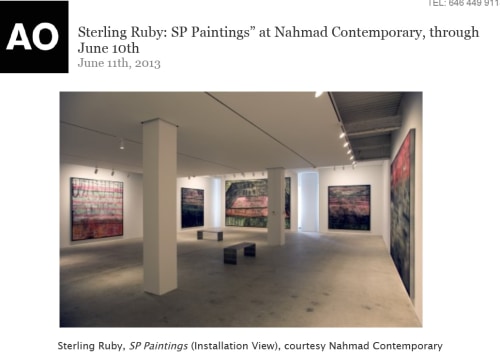
This past month, Nahmad Contemporary was home to its inaugural show, a body of new work by American artist Sterling Ruby, entitled “SP Paintings;” a series he has been developing for a number of years, but has never collectively displayed in an exhibition until now.
Born in Germany in 1972, Ruby created his first large-scale spray paint painting in 2007, a response to his interest in gang tagging and urban demarcation in the city of Los Angeles, where he lives and works. He was first exposed to the idea of aerosol art as a genre when he visited an exhibition on New York graffiti art in Rotterdam when he was much younger, but his own practice in the medium didn’t begin until just 6 years ago.
Organized to show the evolution of Ruby’s exploration of aerosol and spray paint as a creative medium, the works move through a series of thematic and aesthetic stages. At first, Ruby’s SP Paintings were concerned mostly with “a myriad of hegemonic and collective epithets,” but gained more of an awareness of the process as he progressed, becoming occupied with the formal elements of density, overlapping, shading, and diversity of shape and line. Ruby has also developed more of an interest in the titles of the works as markers of thematic content.
Particularly of interest to Ruby is the concept of illicit mergers, as he refers to them. Bearing resemblance to the processes of Abstract Expressionism, he joins symbols that are not often seen together in the same space. Merging the sacred with the profane, and using the language of long-revered artists to express similar aesthetic messages through spray paint, Ruby, like many street artists, is interested in bringing down the walls that separate the formal and the informal, changing the aesthetic accessibility and signifiers of his work.
Also of interest is Ruby’s shifting limits on his spray paint works. Taking a creative practice meant for easy proliferation on any urban surface, he turns the work inward, instead looking to fill a specific space bound by the frame of the canvas instead of the wall or city environments. Ruby’s artistic dialogue with the external practice of spray painting becomes one still bound by the constraints of the gallery, but offers an intriguing look at his act of translation, and his personal flair in brining this stylistic approach to a new ground. The exhibition at Nahmad Contemporary will be accompanied by a fully illustrated catalogue, and closes today at 980 Madison Avenue, New York.
—E. Baker